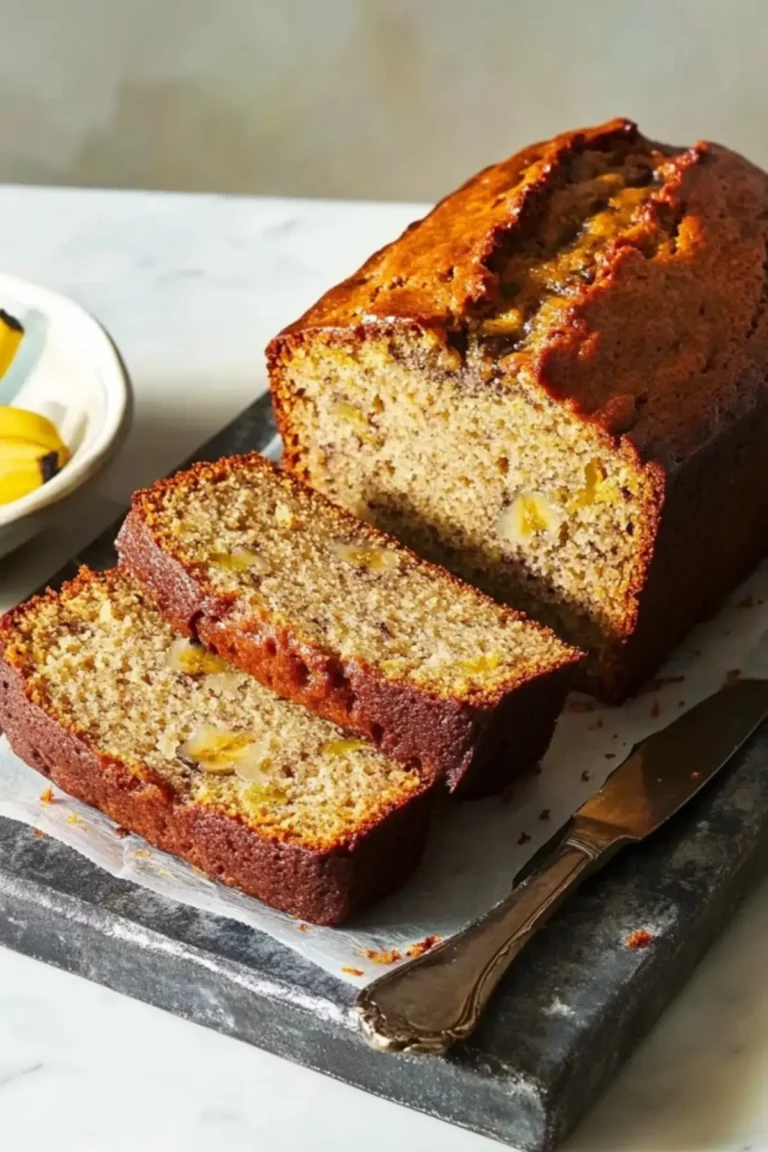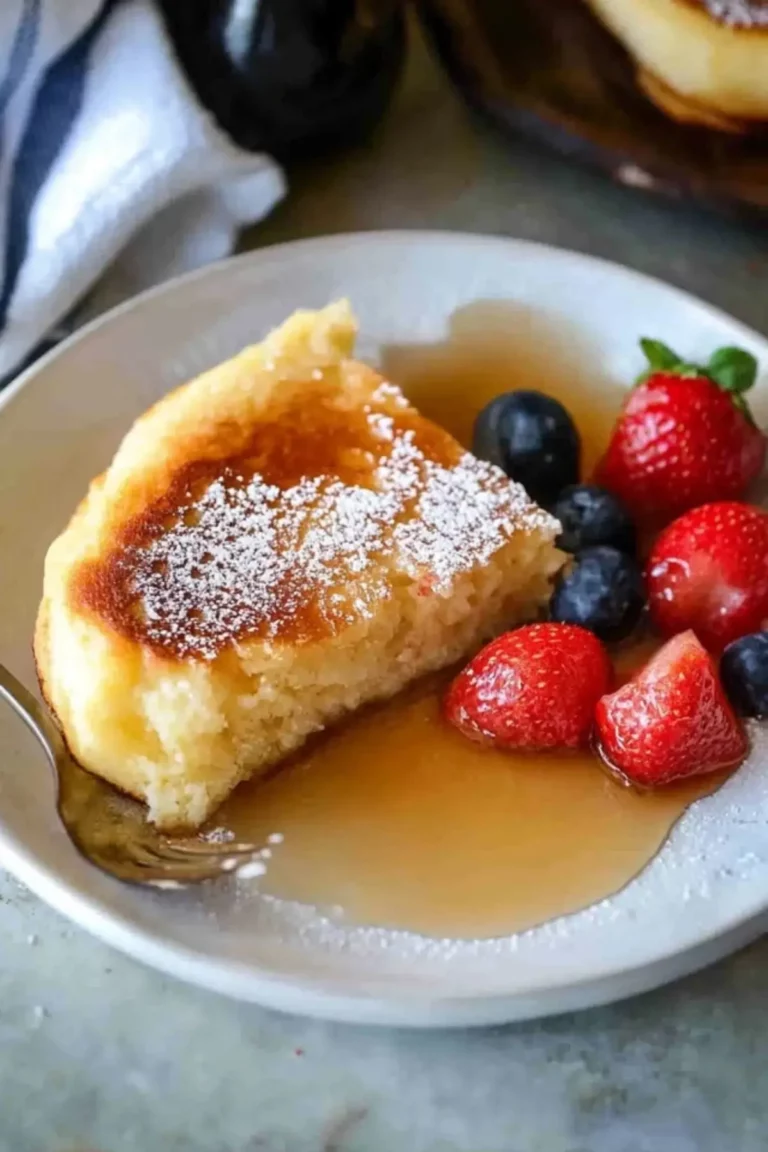There’s something incredibly comforting about the smell of freshly baked bread wafting through the kitchen. The first time I made these Easy No Knead German Crusty Rolls, it was a cold Sunday morning. I stirred together a handful of basic ingredients the night before and let time work its magic. By brunch, we had warm, golden rolls with a crackly crust and an airy, cloud-like interior. They were gone in minutes—no butter left untouched.
What makes these rolls magical is that they don’t demand any fancy techniques or equipment. You don’t even need to knead the dough—hence, the name. This recipe is a gift to beginner bakers and busy home cooks alike. With only a few ingredients and minimal effort, you’ll create bakery-quality bread that’s perfect for any meal. These rolls pair beautifully with lemon herb chicken, making them an ideal component of an easy sheet pan dinner or any lineup of quick and healthy meals.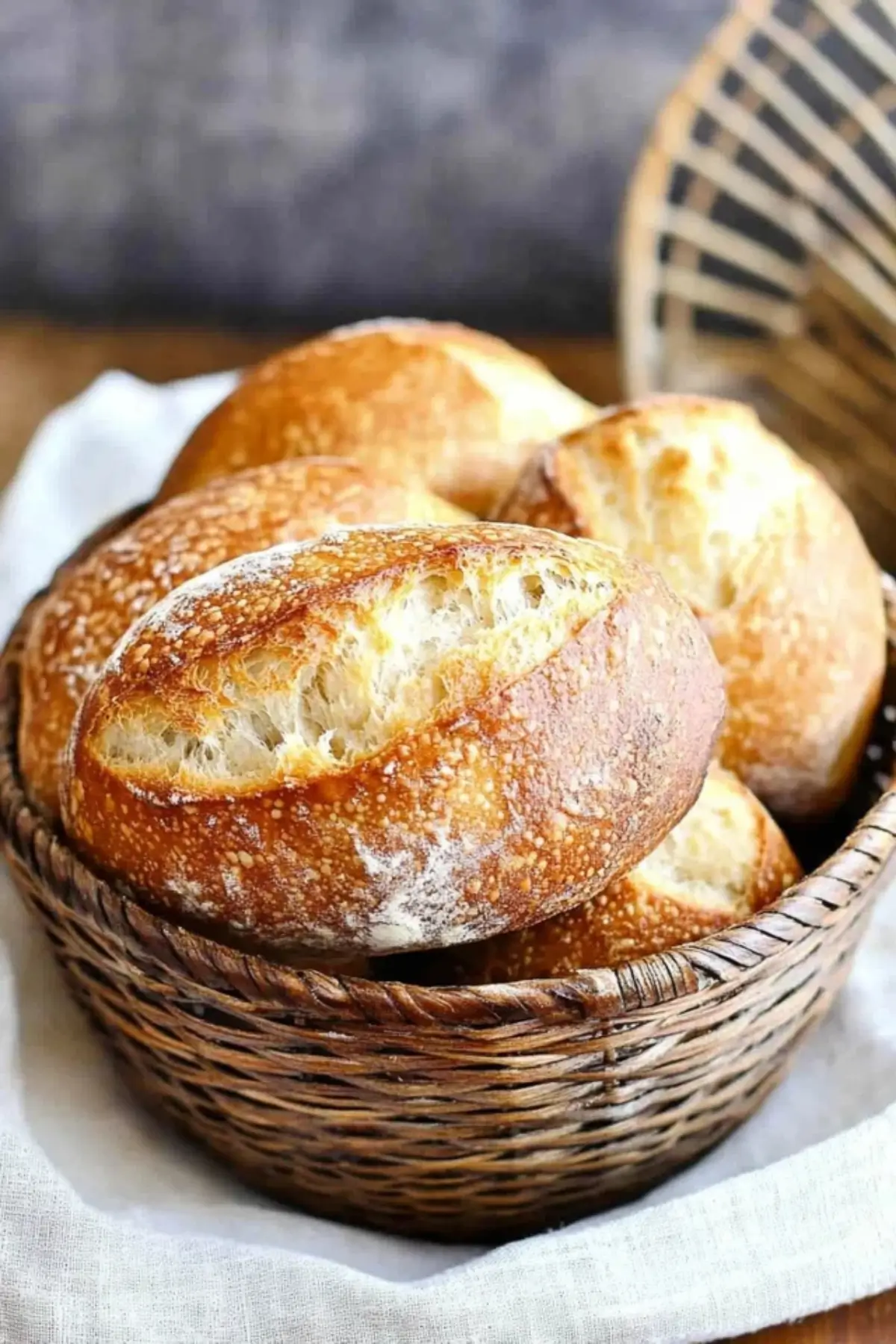
Why These German Crusty Rolls Are Special
These rolls are inspired by the traditional Brötchen commonly served across Germany. You’ll often find them on breakfast tables, alongside meats and cheeses, or nestled beside hearty soups and stews. What sets them apart is their combination of a deeply crisp crust with an unbelievably soft and airy center.
The beauty of this no-knead version lies in its simplicity. There’s no mixer required, no fancy folding techniques, and no need for sourdough starters or long fermenting schedules—just a bit of patience and a warm corner of your kitchen.
Ingredients and Preparation
Bread Flour – This is the backbone of your roll. It provides high protein content that supports the gluten network, giving the rolls a chewy texture and great structure. If you only have all-purpose flour, that will work too, though your crumb may be slightly softer.
Instant Yeast – Used in an ultra-small amount, the yeast does its job quietly overnight. It leavens the dough slowly, allowing flavor to develop without overworking the gluten. If you only have active dry yeast, you can use it as a 1:1 swap, just be sure to dissolve it in water first.
Salt – Beyond enhancing flavor, salt strengthens gluten and helps regulate yeast activity during the long ferment.
Water – Hydrates the dough and activates the yeast. Room temperature is fine—no need to worry about getting the perfect warmth here.
Optional Substitutions:
- Whole wheat flour for a nuttier, more fiber-rich version.
- A touch of olive oil or melted butter for a slightly softer crust.
- Herbs like rosemary or thyme mixed into the dough for extra flavor.
Step-by-Step Instructions
Step 1 Combine the flour and instant yeast in a large mixing bowl. In a separate container, dissolve the salt in room-temperature water. Pour the salted water into the dry mixture and use your hand or a spoon to mix until no dry patches remain. The dough will look messy and shaggy—that’s perfect.
Step 2 Cover the bowl with plastic wrap or a damp kitchen towel and let it sit at room temperature for 12 to 14 hours. Overnight is ideal. The dough will double in size and become bubbly.
Step 3 Once fermented, lightly flour a surface and gently turn out the dough. Divide it into equal portions—aim for about 9 to 12 rolls depending on size preference.
Step 4 Lightly shape each piece into a ball, then form each ball into a tight, oval shape (like a mini football). Don’t stress about perfection. Let them rest on a floured cloth or parchment-lined baking sheet for about an hour.
Step 5 While the rolls are proofing, preheat your oven to 450°F (232°C). If you have a baking stone, place it in the oven now. To mimic a bakery steam oven, put a metal tray on a lower rack.
Step 6 Just before baking, score each roll with a sharp knife or lame. This controls how the rolls expand in the oven. Slide them onto the hot stone or baking sheet and immediately pour hot water into the metal tray to create steam. Bake for 15 to 20 minutes, until golden brown and crackling.
Step 7 Let the rolls cool on a wire rack for at least 10 minutes before digging in. The crust will firm up beautifully as they cool.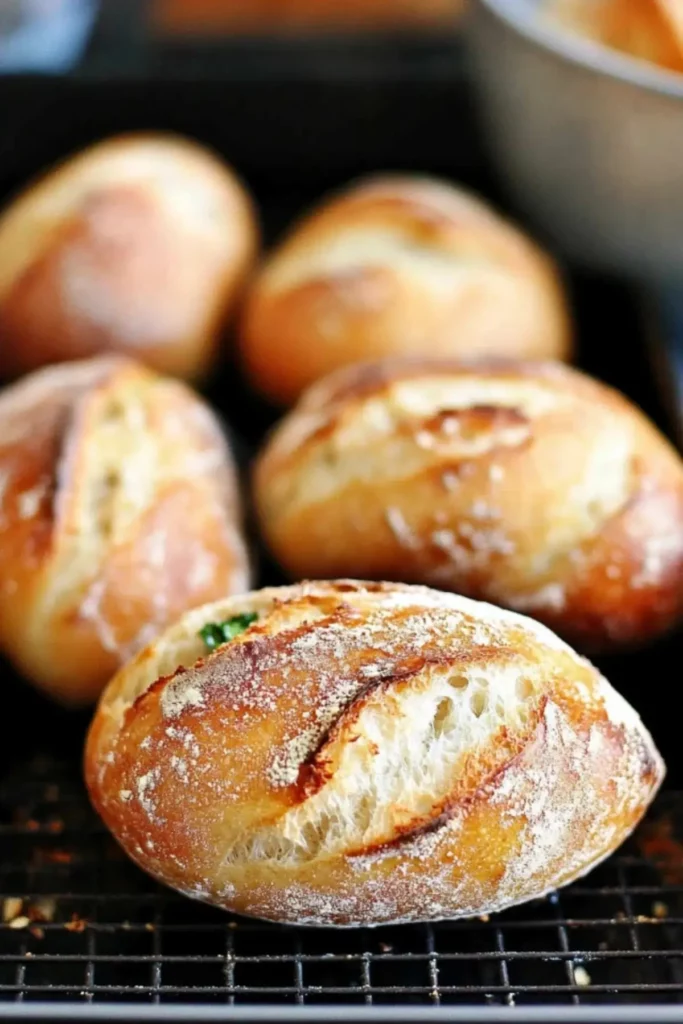
Beginner Tips and Notes
- Dough Not Rising? Check your yeast—it should be fresh and stored in a cool, dry place. If your kitchen is too cold, try placing the dough near a warm appliance or in the oven with the light on.
- Overproofed Dough? If the dough deflates slightly when touched, you’ve overproofed. No big deal—bake them anyway. They’ll still taste great, just slightly flatter.
- No Baking Stone? A preheated heavy-duty baking sheet works well. You can also skip the steam tray and use an inverted foil roasting pan as a lid for the first 10 minutes.
- No Kitchen Scale? While a scale is best for accuracy, you can find cup conversions on King Arthur Baking’s website. If possible, invest in a small digital scale—it’s a game-changer for baking.
Serving Suggestions
These crusty rolls shine in so many roles:
- Serve warm with butter as a side for lemon herb chicken, soup, or stew.
- Use them for sandwiches—they’re sturdy enough to handle juicy fillings like pulled chicken or roasted vegetables.
- Slice and toast for breakfast with jam or avocado.
Storage Tips: Store in a paper bag for up to 2 days to maintain the crust. For longer storage, freeze in a zip-top bag and reheat in a hot oven (400°F) for 10 minutes.
Conclusion
Whether you’re brand new to baking or just looking for a low-effort, high-reward recipe, these no-knead German crusty rolls are the real deal. They bring joy to any meal and build your confidence in the kitchen one golden loaf at a time. If you try this recipe, let me know how it goes in the comments below—I’d love to hear your stories, see your pictures, or answer any questions. Let’s make baking approachable and fun together.
FAQ About Easy No Knead German Crusty Rolls
Can I use all-purpose flour instead of bread flour?
Yes, all-purpose flour works well if bread flour is unavailable. Your rolls may have a slightly softer texture, but they’ll still turn out delicious.
Do I really need to measure 0.2 grams of yeast?
Yes, the low yeast amount allows for a slow fermentation that creates the airy texture. If you don’t have a precision scale, 1/16 teaspoon is close.
What if my dough didn’t rise overnight?
This can happen if your room is too cold or the yeast is expired. Try placing the dough in a slightly warmer spot like inside the oven with the light on.
More Relevant Recipes
- Cheesy Garlic Bread Recipe
- Fluffy Garlic Butter Breadsticks
- Cheesecake Factory Brown Bread – Milk and Pop
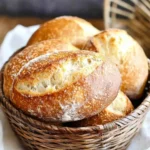
Easy No Knead German Crusty Rolls
- Total Time: 13 hours
- Yield: 18 rolls 1x
Description
These Easy No Knead German Crusty Rolls are crunchy on the outside, airy on the inside, and perfect for sandwiches or as a side to any meal. A great bread recipe for beginners.
Ingredients
- 1000 grams bread flour
- 0.2 grams instant yeast
- 680 grams water
- 22 grams salt
Instructions
- Mix the Dough: In a large mixing bowl, whisk together the bread flour and instant yeast. In a separate bowl, dissolve the salt in the water. Pour the salted water into the flour mixture and stir with your hand or a wooden spoon until fully combined. The dough should look shaggy and wet.
- Let It Ferment: Cover the bowl with plastic wrap or a clean kitchen towel and let it rest at room temperature for 12 to 14 hours. During this time, the dough will double in size and become bubbly and airy.
- Divide and Shape: Lightly flour a surface and turn out the dough. Divide it into 18 equal portions (about 94 grams each). Gently shape each into a loose ball and let them rest for 25 minutes. Then, reshape each ball into a tight, oval shape resembling a mini batard.
- Proof the Rolls: Place the shaped rolls on a floured couche, parchment-lined baking sheet, or floured towel. Cover loosely and let rise for 1 hour until slightly puffy.
- Preheat and Prepare the Oven: Preheat your oven to 450°F (232°C). Place a baking stone or heavy-duty baking sheet in the oven and a separate metal tray on the lower rack for steam.
- Score and Bake: Score the tops of the rolls with a sharp blade. Carefully transfer them to the hot baking surface. Immediately pour hot water into the steam tray and quickly close the oven door. Bake for 15 to 20 minutes until the crust is golden brown and the rolls sound hollow when tapped.
- Cool and Serve: Let the rolls cool on a wire rack for at least 10 minutes before serving. This helps set the crust and makes slicing easier.
Notes
- These rolls can be made ahead and frozen.
- For a slightly softer crust, skip the steam step.
- For more flavor, mix in herbs like rosemary or thyme.
- No kitchen scale? Use a reliable flour-to-cup conversion chart like King Arthur Baking’s.
- Prep Time: 30 minutes
- Cook Time: 20 minutes
- Category: Bread
- Method: Baking
- Cuisine: German
Nutrition
- Serving Size: 1 roll
- Calories: 200
- Sugar: 0.17 g
- Sodium: 477 mg
- Fat: 0.92 g
- Saturated Fat: 0.14 g
- Unsaturated Fat: 0.78 g
- Trans Fat: 0 g
- Carbohydrates: 40.29 g
- Fiber: 1.33 g
- Protein: 6.66 g
- Cholesterol: 0 mg

